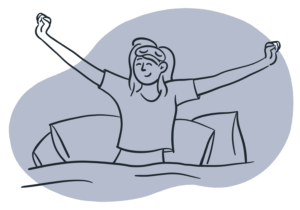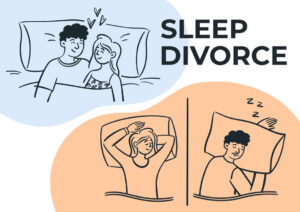Couples Sleep Guide
Disclosure: By clicking on the product links in this article, Mattress Nerd may receive a commission fee at no cost to you, the reader. Read full disclosure statement.
The science of sleep is traditionally conceptualized and evaluated based on an individual’s experience. But, the reality is many people are not sleeping in their bed alone. Sleeping with a partner can have a tremendous impact on your sleep, according to a University of Pittsburgh study.
“Sleeping together is fundamental to increase intimacy and to build in the ritual of connection,” says Carla Picolli, a psychologist and certified sleep consultant. “Sleeping well—and together—will not only increase immunity, health, energy, good mood, productivity, creativity, but also men’s testosterone levels and women’s hormones, increasing sed drive for both.”
On the other hand, “a bed partner’s habits or pathologies can also have a negative effect on your health,” says Dr. Kent Smith, sleep expert and president of the American Sleep & Breathing Academy. “For those of us who share a bed with someone, oftentimes, it is not our own habits that disrupt sleep, but those of our partner’s,” he says.
Other common sleep disrupters include fear, anxiety, and stress—emotions a global pandemic can stir. Does cuddling with your partner help ease your distress, or cause one or both of you to toss and turn more at night?
The review team at Mattress Nerd wanted to better understand how sleeping with a partner impacts sleep, and how COVID-19 played a role in the quality of couples’ sleep. So, we polled our readers to find out.

According to our survey, 97 percent of respondents say they share a bed with a significant other. Slightly more than half (56 percent) say they are getting about 6 to 7 hours of sleep at night—slightly less than the 7 to 9 hours of sleep recommended by sleep experts. COVID-19 could be the culprit. More than 10 percent of our survey respondents said they were dealing with anxiety, fear, and stress.
“COVID disturbed our sleep style,” says one survey participant. “Due to COVID, we’ve had a lot more time together. Unfortunately, that has led to frequent arguments, therefore we don’t want to sleep together,” says another.
Those comments were balanced by more positive ones, such as: “I felt comforted knowing I was with my husband. Like a safety net,” says one respondent. “COVID made us even closer,” adds another.
Here’s what else our research told us about couples sleeping.
Sleeping Positions for Couples
How couples sleep together can provide clues to their individual personalities and how well they get along, according to a University of Hertfordshire study. According to the research:
- 42 percent of couples sleep back-to-back
- 31 percent of couples sleep facing the same direction
- 4 percent of couple sleep facing each other
How close they slept was also telling—12 percent reported sleeping one inch apart while 2 percent say they sleep more than 30 inches apart. “One of the most important differences involved touching, with 94 percent of couples who spend the night in contact with one another were happy with their relationship compared to just 68 percent of those that didn’t touch,” says lead researcher, psychologist Richard Wiseman.
Sleep position can also be revealing, says relationship psychologist Corinne Sweet. “Inevitably, once the first flush of lust wears off, with couples naked and entwined, it is more likely that the need for a good night’s sleep predominates, so sleeping back-to-back becomes a favorable position in bed.”
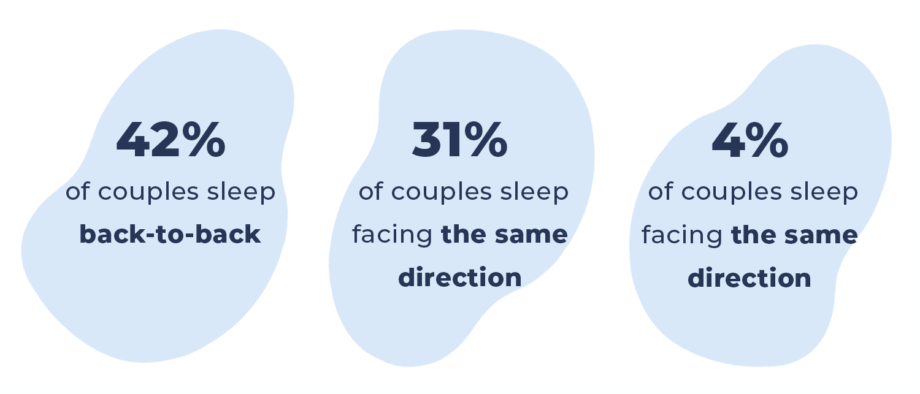
Here are of the most popular sleeping positions for couples and what each says about your relationship:
- Liberty: This popular position of lying back-to-back without touching suggests the individuals feel a sense of independence along with connectedness. This sleep style can reveal a couple’s comfort with each other. “It’s also a good way to enjoy a night’s rest without disturbing the other person too much,” Dr. Smith says.
- Cherish: Sleeping back-to-back while touching indicates a similar comfort level along with intimacy. This position is more often seen in newer relationships.
- Spoons: sleeping back-to-belly, like two spoons in a kitchen drawer, is a traditional position in which one of the two partners takes a lead and protects their partner by surrounding their body with theirs. It’s both a sign of strong sexuality and security and is more often seen in newer relationships. “Spooning is known to be comforting and is good for warming up during cold nights,” says Dr. Smith.
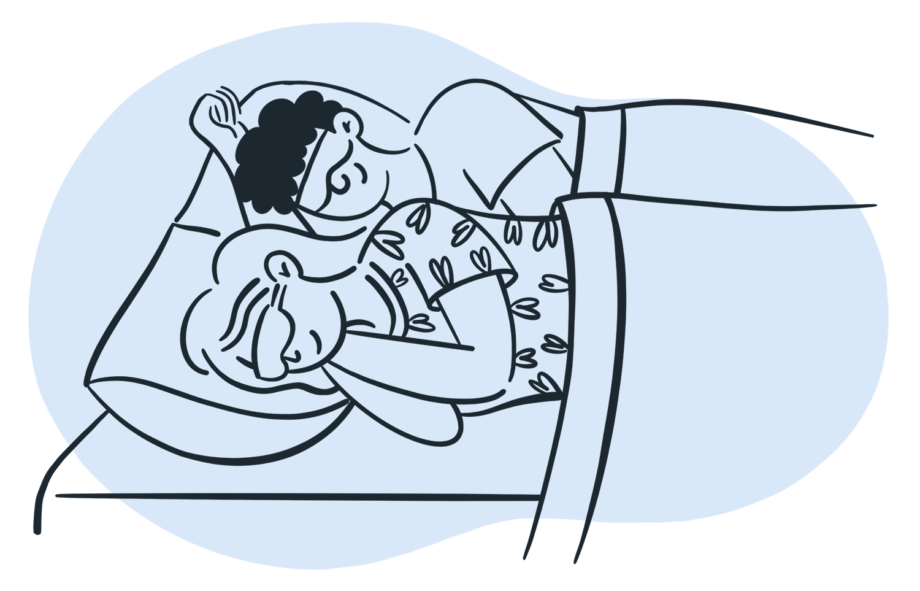
- Pillow talk: Sleeping face-to-face indicates a sense of intimacy and a need to stay connected even in sleep
- Lover’s knot/Intertwined: Sleeping cuddled up face-to-face with legs intertwined demonstrates intimacy and independence. That’s because most couples only stay in this position for about 10 minutes before separating.
- The Lovers: This position involves keeping the lover’s knot position through the night. Sleeping like the lovers suggests a physical and emotional inseparableness.
- The Romantic/Sweetheart Cradle: Sleeping with one partner’s head resting on the chest of the other, with each having an arm around the other, indicates a relationship filled with what the name suggests: intimacy and nurturing.
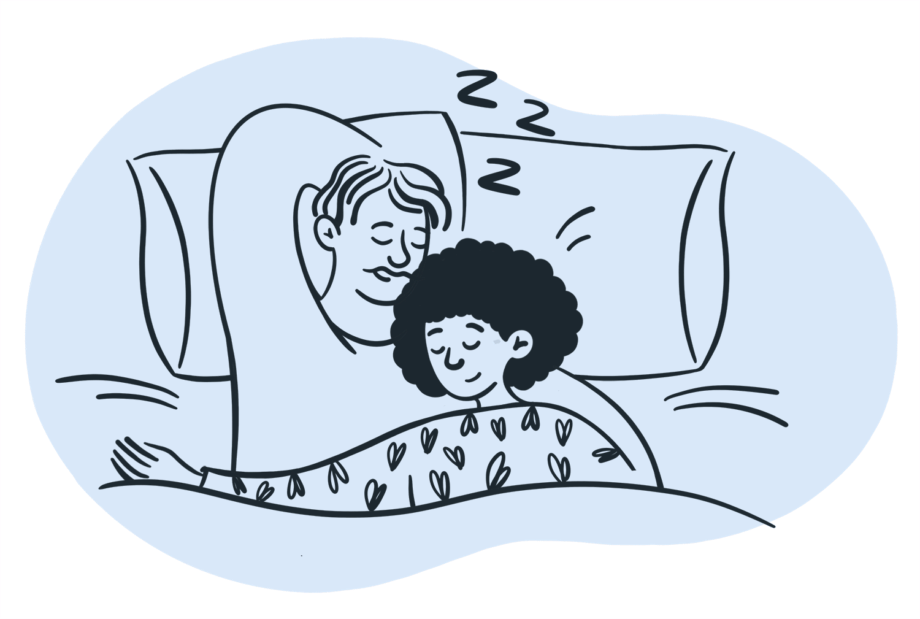
- Superwoman/man: This position is where one partner is lying in starfish position taking up most of the bed while the other partner clings to the edge. It indicates that the starfish in this scenario likes to have his or her way while their partner is happy to give them space.
- Both on stomach: Sleeping on your stomach suggests feelings of anxiety or fear. If both you and your partner are sleeping on your stomachs, it may indicate one or both of you is feeling relational anxiety or lack of sexual trust.
Related: Best Mattresses for Couples
Benefits of Sleeping with a Partner
Sleeping with someone during stressful moments in life, such as the coronavirus pandemic, can give you a sense of calm even if you and your partner aren’t touching. That’s because sleeping with someone you care about triggers positive chemical reactions in the body, Dr. Smith explains.
“Sleeping with a significant other increases oxytocin, a chemical that is produced in the same part of the brain that controls your sleep-wake cycle. Sharing a bed also helps you feel more connected in your relationship, lowering your risk for developing depression,” he says. “Sleeping next to the one you love also produces feelings of safety, security, and protection. These emotions decrease anxiousness and lower the body’s levels of the stress hormone cortisol, allowing for more peaceful and restorative sleep.”
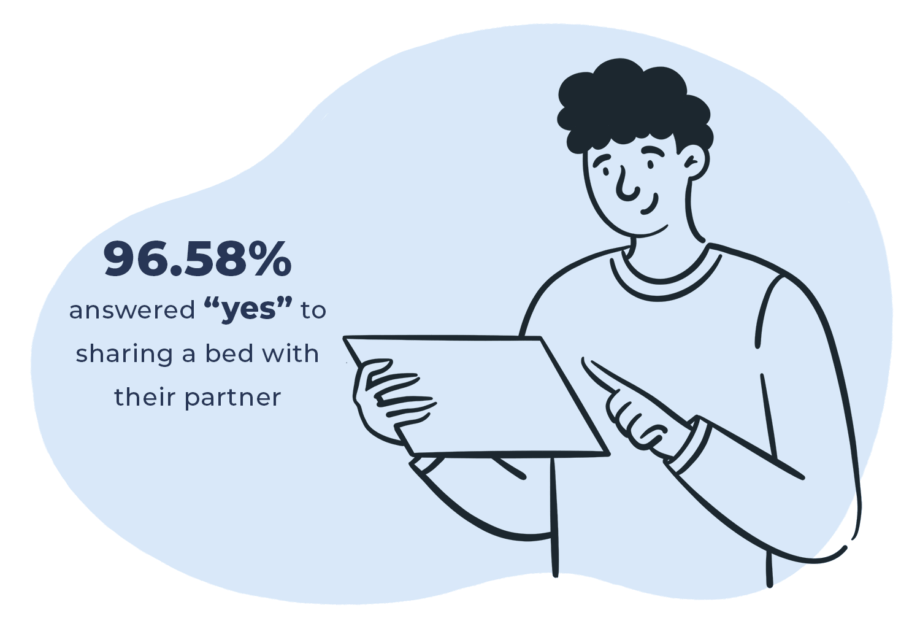
It also improves the way couples interact with each other, helping to strengthen each person’s physical and mental health, according to research published in the journal Psychosomatic Medicine.
“People with healthy and consistent sleep habits are less likely to become sleep deprived,” Dr. Smith says. “Over the long term, sleep deprivation can lead to serious conditions including heart disease, obesity, sleep apnea, and insulin resistance – not to mention fatigue, slower reaction times, a compromised immune system, and irritability.”
Challenges to Sleeping with a Partner
Despite the benefits of sleeping with a partner, there are some drawbacks, says Nathan Frederick, product director at Ancient Posture.
“People have different preferences when it comes to sleep, and sharing a bed with somebody creates nuances that may disrupt what an individual considers a good night’s sleep,” he says. “Some people like hugging and cuddling when they sleep while others find it uncomfortable. Some can’t sleep with a light on; others can’t with the lights off. It’s this clashing of individual sleep preferences that lead to couples having sleep problems. Couples need to talk these through and come up with a reasonable compromise if they are to sleep together.”
For example, if you and your partner are extreme opposites when it comes to what to set the thermometer at during the night, compromise by choosing a temperature in the middle. The colder sleep can add an extra blanket to the bed while the hotter sleeper can opt to sleep naked.
“Sleeping naked, or with as little clothing as possible, not only helps improve your sleep but improves your overall health as well,” says Dr. Smith.
But if the issue stems from something more serious, such as a sleeping disorder, start from a place of compassion, Picolli suggests. “The first thing to remember is that 1 in 3 people have a sleeping problem. Therefore, the change of one of the people in this relationship having a sleep problem, such as sleep apnea, is high.”
One of the biggest problems our review team noticed among the few participants of our survey who struggled to get good sleep was because their partner’s snoring kept them awake at night. The snoring partner should consider treatment options to help them stop snoring. Otherwise, it may be time to discuss a sleep divorce.
Before you gasp, a sleep divorce—where you keep your relationship but choose to sleep in different beds—isn’t necessarily a bad thing. And it certainly doesn’t mean your sex life has to suffer. In fact, since you’ll both enjoy better sleep, you’ll be far better rested for intimacy.
How to Sleep Better with Your Partner
Good sleep together is possible. If you and your partner are struggling to get a good night’s sleep together, consider these options before seeking a sleep divorce:
A queen-size mattress offers plenty of room if you sleep spooned together all night long. But let’s face it, it’s easier to fall asleep when you’re not tangled up in your partner’s arms and legs. Not only can it get uncomfortable, it can get hot. If you’ve got the room in your bedroom, consider a king-size or California king bed instead.
“My husband can’t sleep on the mattress we currently have. Every time he tries, he wakes up with a backache,” one survey respondent says. Comfort is key for both partners in a relationship, but you should also look for mattresses that feature motion isolation. This prevents you from being shaken awake if your partner tosses and turns or gets up in the middle of the night for a bathroom break.
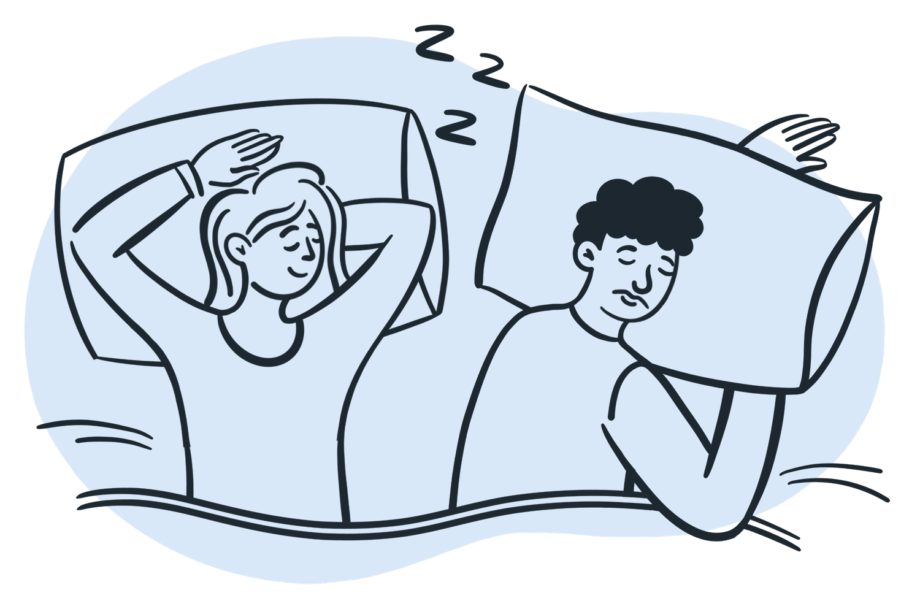
If you and your bed partner prefer different sleep temperatures, consider sleeping under separate blankets. Hot sleepers will appreciate a lighter-weight throw while cold sleepers can snuggle under a cozier blanket or even a weighted blanket.
Establishing a bedtime routine can improve sleep quality in adults the same way it does with young children. About 30 minutes before bedtime, start to wind yourselves down by turning off the TV and other electronic devices, showering or taking a warm bath, and reading or listening to soothing music together.
Final Thoughts
Research has shown that sleeping with someone you care about can help you sleep better. It can also promote intimacy and improve your health and wellbeing. But sometimes sharing a bed—even with someone you love—can be anything but restful.
Whether your partner tosses and turns due to stress, suffers from a disruptive sleep disorder, or your sleep habits are that different, it is possible to overcome your sleep issues so that you both get a good night’s rest. Consider making some changes and, if necessary, seek the help of a sleep specialist or couples’ therapist.
Even if you decide a sleep divorce is best, it doesn’t mean your relationship has to suffer. In fact, separating at night so you can both sleep well may be the best thing to happen to your relationship.
